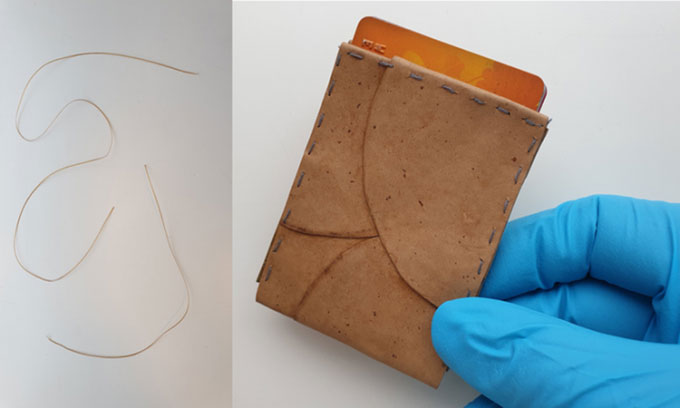New fake leather made from mushrooms growing on old bread
The new type of imitation leather has many of the same properties as real leather, uses natural materials that are not harmful to the environment, and has a short production time.
Experts at Boras University (Sweden), found a way to make sustainable imitation leather from mushrooms. The team confirms that this fungus skin requires less time to produce than current imitation leather and is completely biological in origin. The study results were presented at the spring meeting of the American Chemical Society (ACS) on March 23.

The mycelium can be used as thread (left) or fabricated into imitation leather (right).
To create the new material, the team used spores of the fungus Rhizopus delemar, which often appear on rotting food. They fed the mushrooms stale bread that couldn't be sold at the supermarket, then dried, crumbled and mixed with water in an experimental reactor. When eating bread, the fungus produces microscopic natural fibers from chitin and chitosan that accumulate in the cell walls. The fungal cell suspension is then flattened and dried to produce a skin-like material.
The first mushroom skin prototypes were thin and not flexible enough, said Dr Akram Zamani at Boras University, who led the research. They are developing thicker versions with multiple layers to make the product more like animal skin. They include layers treated with plant-based tannins for structural softness, combined with alkaline treatments for strength. Flexibility, sturdiness and gloss are also increased by treatment with glycerol and bio-adhesives.
"Our recent tests show that mushroom skin has quite similar mechanical properties to real leather," said Zamani. For example, the correlation between density and hardness of two materials is similar.
This isn't the first mushroom-based skin substitute. Last year, biomaterials company MycoWorks based in San Francisco (USA) introduced a fake skin made of mycelium - the tubular filaments on mushrooms.
However, Zamani said, most such commercial products are made from harvested mushrooms or thin layers of fungi that grow on food waste or sawdust, using a solid-state fermentation method. These methods require days or weeks to produce enough fungal material, while the team's mushrooms are soaked in water and only take a few days to produce the same amount of material.
In addition, some mushroom skins on the market contain environmentally harmful coatings or reinforcement with synthetic polymers derived from petroleum, such as polyester. Meanwhile, the product of the Boras University team consists of only natural and biodegradable materials.
Not only imitation leather, but also paper products and cotton substitutes can be made by new methods. After feeding the mushrooms with bread for two days, the expert team collected cells, removing lipids, proteins and other byproducts that could be used for food or animal feed. The jelly-like residue consisting of the cell walls will be spun and can be used for sutures, dressings, and even clothing.
Zamani hopes they will replace cotton or synthetic fibers that can have a negative impact on the environment. "During the development of the manufacturing process, we were careful not to use harmful chemicals or anything that is harmful to the environment," she said.
- Unbelievable special skin made entirely from ... mushrooms!
- Listening to the people of the net, the Japanese boy was always drinking wild mushrooms growing in the bathroom
- Development of artificial skin from mushrooms that looks like real leather
- Help the young face to be 20 years old by 'applying' artificial skin
- Bread plants Arctocarpus altilis
- Artificial skin feels real
- Bread and more than 14,000 years of history
- Protein-rich bread made from cockroaches
- Sliced bread - eat all day, but how does it come about, not everyone knows
- What happens when you regularly eat bread?
- What do you think if you eat a bread made from cockroaches?
- The world's first prosthetic body
 The US company is about to build a supersonic passenger plane of 6,000km / h
The US company is about to build a supersonic passenger plane of 6,000km / h Japan develops avatar robot as in fiction film
Japan develops avatar robot as in fiction film Australia tested the world's first mango picking robot
Australia tested the world's first mango picking robot America develops technology to separate water from animal waste
America develops technology to separate water from animal waste